University Nursing PICO Assignment: Handwashing Effectiveness Study
VerifiedAdded on 2022/08/23
|6
|1221
|13
Homework Assignment
AI Summary
This assignment presents a PICO question focused on the effectiveness of handwashing practices in a nephrology unit. The question investigates whether the use of alcohol-based hand rubs is more effective than soap and water in reducing communicable infections among nurses and patients. The assignment details the population of interest (nurses in a nephrology unit), the intervention (alcohol-based handwashing), the comparison (soap and water handwashing), and the desired outcome (reduced pathogen transfer). The student argues that alcohol-based handwashing is more effective due to its stronger antimicrobial properties. The assignment includes references to support the claims, citing research studies on hand hygiene practices and infection control in healthcare settings. The goal is to highlight the importance of hand hygiene in preventing the spread of infections within a healthcare environment, particularly in a unit with vulnerable patients.
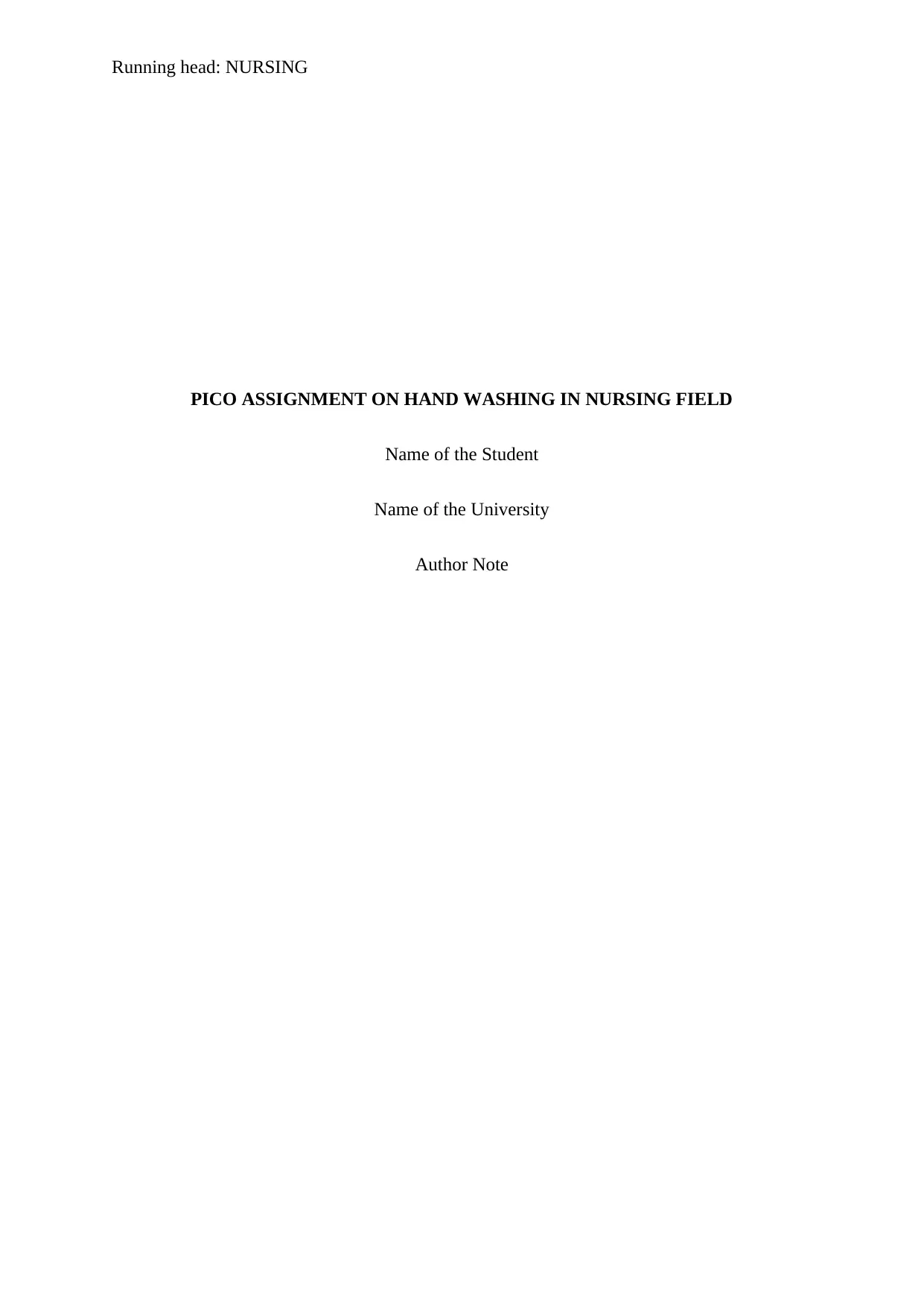
Running head: NURSING
PICO ASSIGNMENT ON HAND WASHING IN NURSING FIELD
Name of the Student
Name of the University
Author Note
PICO ASSIGNMENT ON HAND WASHING IN NURSING FIELD
Name of the Student
Name of the University
Author Note
Paraphrase This Document
Need a fresh take? Get an instant paraphrase of this document with our AI Paraphraser
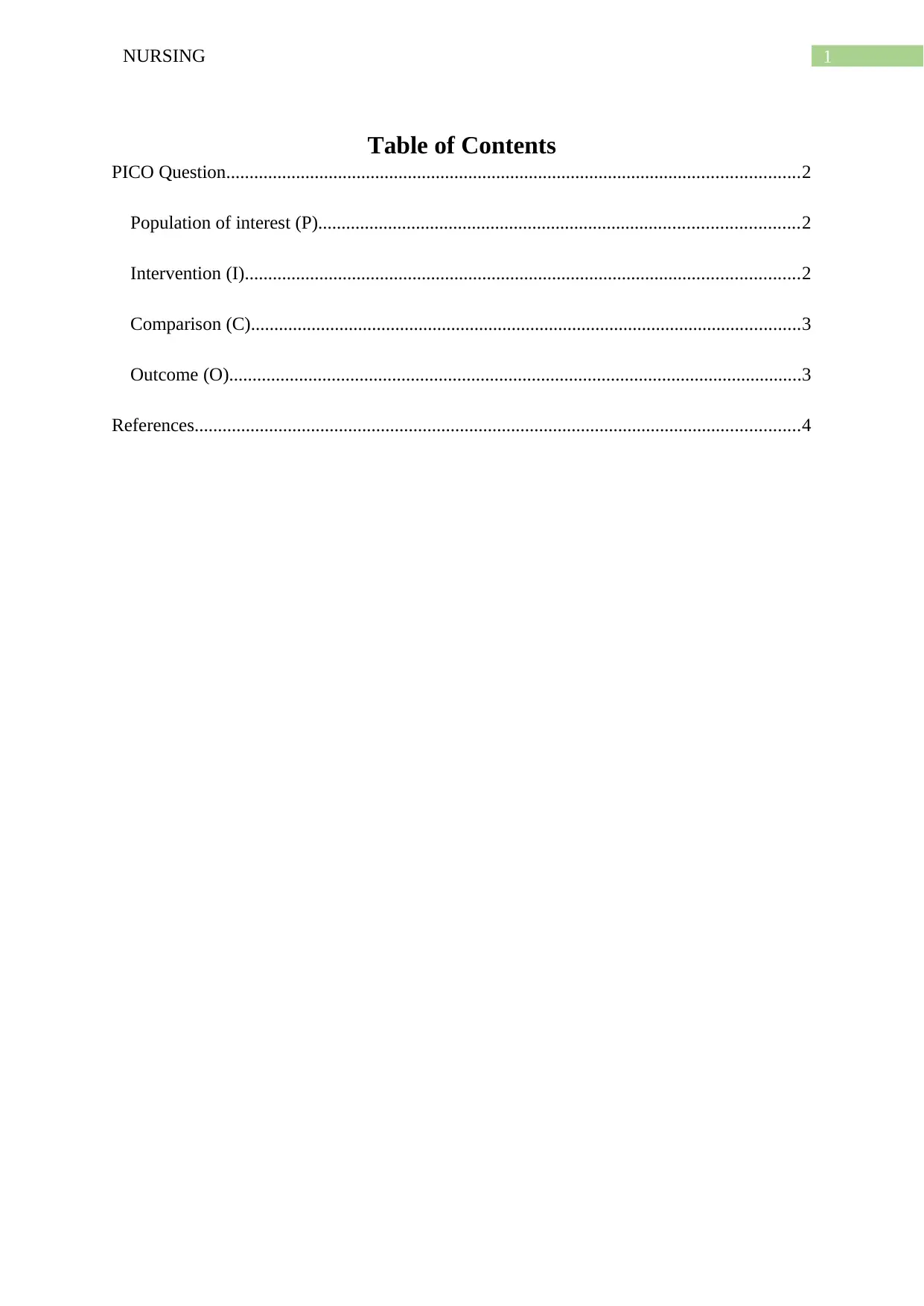
1NURSING
Table of Contents
PICO Question...........................................................................................................................2
Population of interest (P).......................................................................................................2
Intervention (I).......................................................................................................................2
Comparison (C)......................................................................................................................3
Outcome (O)...........................................................................................................................3
References..................................................................................................................................4
Table of Contents
PICO Question...........................................................................................................................2
Population of interest (P).......................................................................................................2
Intervention (I).......................................................................................................................2
Comparison (C)......................................................................................................................3
Outcome (O)...........................................................................................................................3
References..................................................................................................................................4
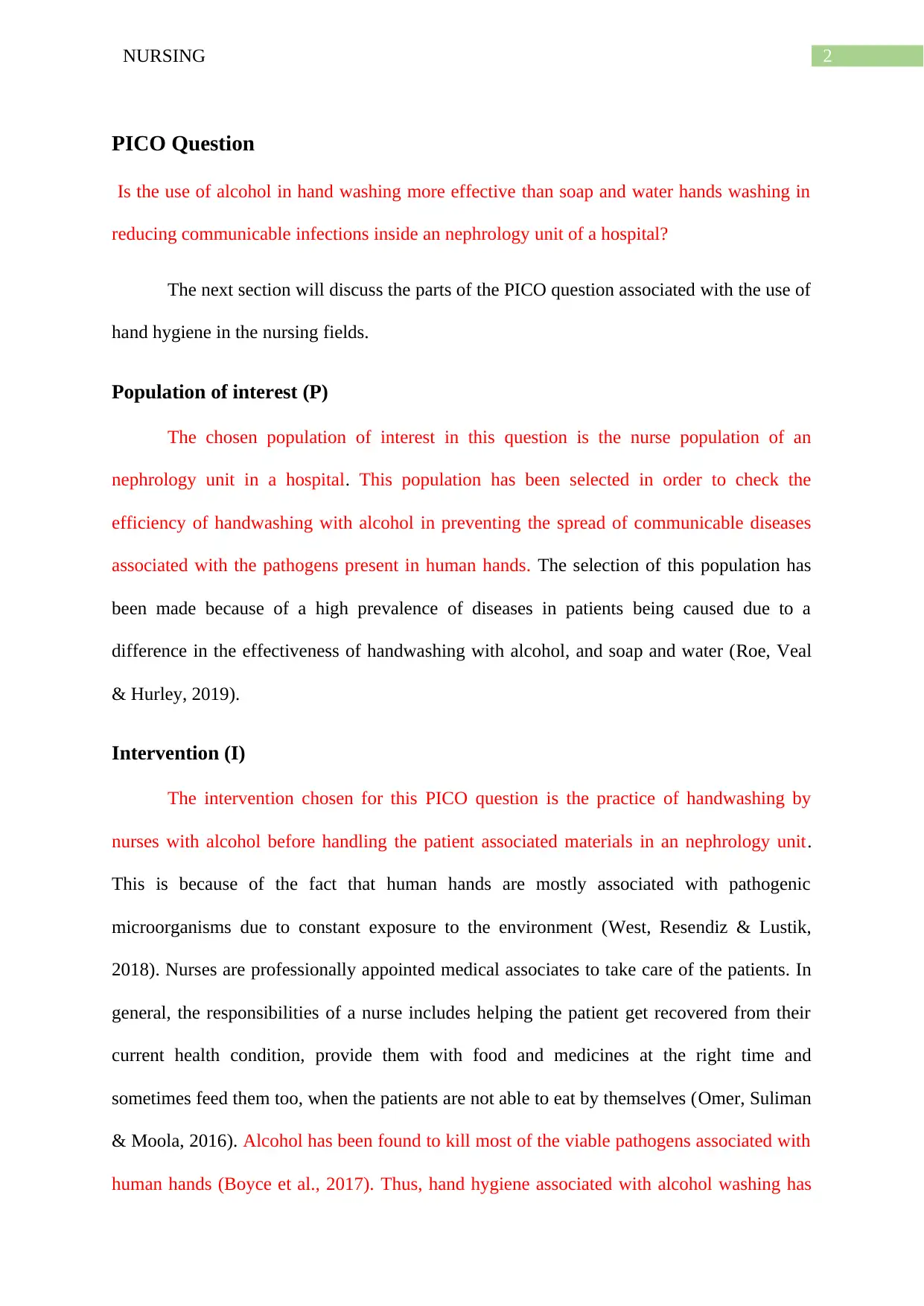
2NURSING
PICO Question
Is the use of alcohol in hand washing more effective than soap and water hands washing in
reducing communicable infections inside an nephrology unit of a hospital?
The next section will discuss the parts of the PICO question associated with the use of
hand hygiene in the nursing fields.
Population of interest (P)
The chosen population of interest in this question is the nurse population of an
nephrology unit in a hospital. This population has been selected in order to check the
efficiency of handwashing with alcohol in preventing the spread of communicable diseases
associated with the pathogens present in human hands. The selection of this population has
been made because of a high prevalence of diseases in patients being caused due to a
difference in the effectiveness of handwashing with alcohol, and soap and water (Roe, Veal
& Hurley, 2019).
Intervention (I)
The intervention chosen for this PICO question is the practice of handwashing by
nurses with alcohol before handling the patient associated materials in an nephrology unit.
This is because of the fact that human hands are mostly associated with pathogenic
microorganisms due to constant exposure to the environment (West, Resendiz & Lustik,
2018). Nurses are professionally appointed medical associates to take care of the patients. In
general, the responsibilities of a nurse includes helping the patient get recovered from their
current health condition, provide them with food and medicines at the right time and
sometimes feed them too, when the patients are not able to eat by themselves (Omer, Suliman
& Moola, 2016). Alcohol has been found to kill most of the viable pathogens associated with
human hands (Boyce et al., 2017). Thus, hand hygiene associated with alcohol washing has
PICO Question
Is the use of alcohol in hand washing more effective than soap and water hands washing in
reducing communicable infections inside an nephrology unit of a hospital?
The next section will discuss the parts of the PICO question associated with the use of
hand hygiene in the nursing fields.
Population of interest (P)
The chosen population of interest in this question is the nurse population of an
nephrology unit in a hospital. This population has been selected in order to check the
efficiency of handwashing with alcohol in preventing the spread of communicable diseases
associated with the pathogens present in human hands. The selection of this population has
been made because of a high prevalence of diseases in patients being caused due to a
difference in the effectiveness of handwashing with alcohol, and soap and water (Roe, Veal
& Hurley, 2019).
Intervention (I)
The intervention chosen for this PICO question is the practice of handwashing by
nurses with alcohol before handling the patient associated materials in an nephrology unit.
This is because of the fact that human hands are mostly associated with pathogenic
microorganisms due to constant exposure to the environment (West, Resendiz & Lustik,
2018). Nurses are professionally appointed medical associates to take care of the patients. In
general, the responsibilities of a nurse includes helping the patient get recovered from their
current health condition, provide them with food and medicines at the right time and
sometimes feed them too, when the patients are not able to eat by themselves (Omer, Suliman
& Moola, 2016). Alcohol has been found to kill most of the viable pathogens associated with
human hands (Boyce et al., 2017). Thus, hand hygiene associated with alcohol washing has
⊘ This is a preview!⊘
Do you want full access?
Subscribe today to unlock all pages.

Trusted by 1+ million students worldwide
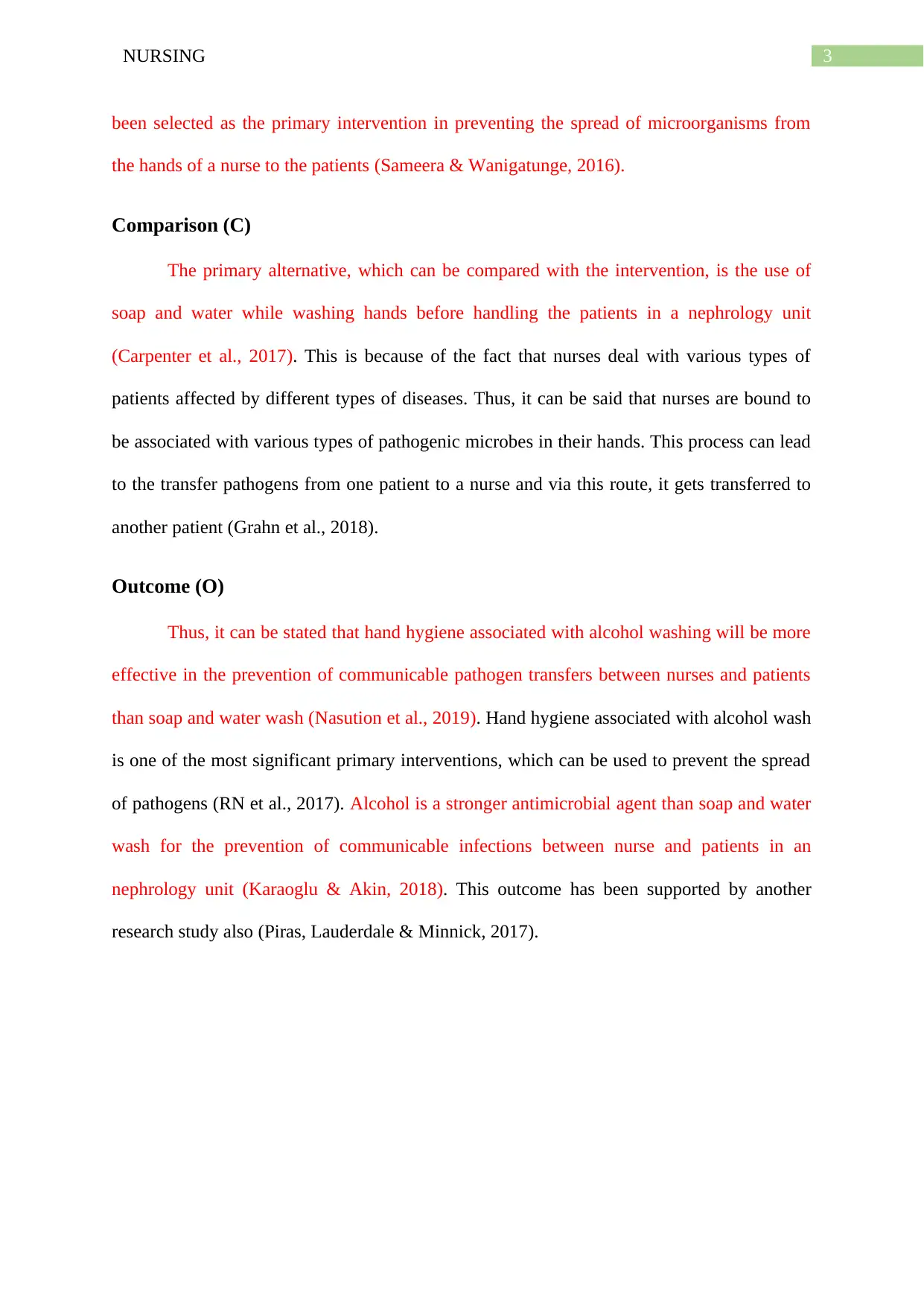
3NURSING
been selected as the primary intervention in preventing the spread of microorganisms from
the hands of a nurse to the patients (Sameera & Wanigatunge, 2016).
Comparison (C)
The primary alternative, which can be compared with the intervention, is the use of
soap and water while washing hands before handling the patients in a nephrology unit
(Carpenter et al., 2017). This is because of the fact that nurses deal with various types of
patients affected by different types of diseases. Thus, it can be said that nurses are bound to
be associated with various types of pathogenic microbes in their hands. This process can lead
to the transfer pathogens from one patient to a nurse and via this route, it gets transferred to
another patient (Grahn et al., 2018).
Outcome (O)
Thus, it can be stated that hand hygiene associated with alcohol washing will be more
effective in the prevention of communicable pathogen transfers between nurses and patients
than soap and water wash (Nasution et al., 2019). Hand hygiene associated with alcohol wash
is one of the most significant primary interventions, which can be used to prevent the spread
of pathogens (RN et al., 2017). Alcohol is a stronger antimicrobial agent than soap and water
wash for the prevention of communicable infections between nurse and patients in an
nephrology unit (Karaoglu & Akin, 2018). This outcome has been supported by another
research study also (Piras, Lauderdale & Minnick, 2017).
been selected as the primary intervention in preventing the spread of microorganisms from
the hands of a nurse to the patients (Sameera & Wanigatunge, 2016).
Comparison (C)
The primary alternative, which can be compared with the intervention, is the use of
soap and water while washing hands before handling the patients in a nephrology unit
(Carpenter et al., 2017). This is because of the fact that nurses deal with various types of
patients affected by different types of diseases. Thus, it can be said that nurses are bound to
be associated with various types of pathogenic microbes in their hands. This process can lead
to the transfer pathogens from one patient to a nurse and via this route, it gets transferred to
another patient (Grahn et al., 2018).
Outcome (O)
Thus, it can be stated that hand hygiene associated with alcohol washing will be more
effective in the prevention of communicable pathogen transfers between nurses and patients
than soap and water wash (Nasution et al., 2019). Hand hygiene associated with alcohol wash
is one of the most significant primary interventions, which can be used to prevent the spread
of pathogens (RN et al., 2017). Alcohol is a stronger antimicrobial agent than soap and water
wash for the prevention of communicable infections between nurse and patients in an
nephrology unit (Karaoglu & Akin, 2018). This outcome has been supported by another
research study also (Piras, Lauderdale & Minnick, 2017).
Paraphrase This Document
Need a fresh take? Get an instant paraphrase of this document with our AI Paraphraser
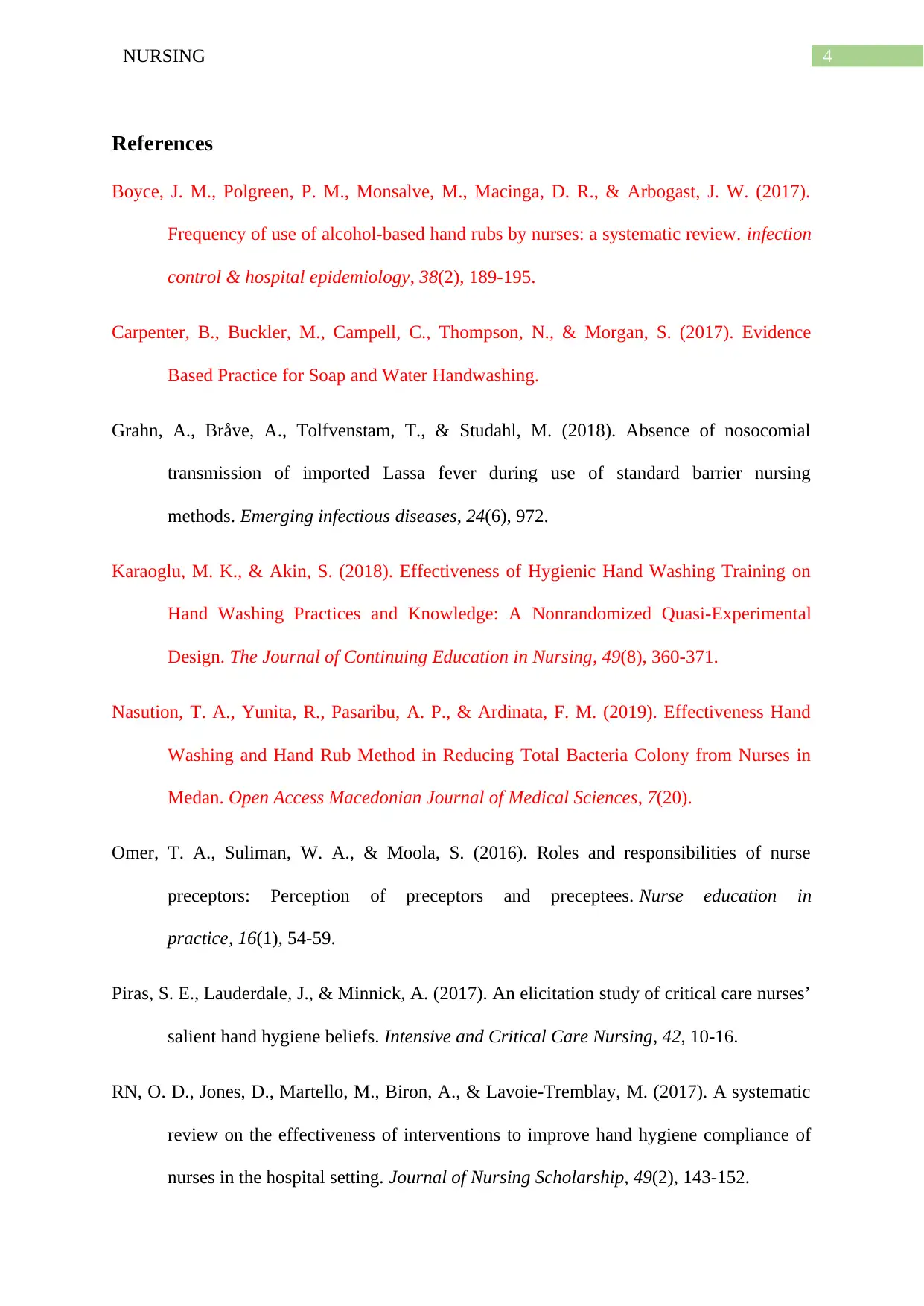
4NURSING
References
Boyce, J. M., Polgreen, P. M., Monsalve, M., Macinga, D. R., & Arbogast, J. W. (2017).
Frequency of use of alcohol-based hand rubs by nurses: a systematic review. infection
control & hospital epidemiology, 38(2), 189-195.
Carpenter, B., Buckler, M., Campell, C., Thompson, N., & Morgan, S. (2017). Evidence
Based Practice for Soap and Water Handwashing.
Grahn, A., Bråve, A., Tolfvenstam, T., & Studahl, M. (2018). Absence of nosocomial
transmission of imported Lassa fever during use of standard barrier nursing
methods. Emerging infectious diseases, 24(6), 972.
Karaoglu, M. K., & Akin, S. (2018). Effectiveness of Hygienic Hand Washing Training on
Hand Washing Practices and Knowledge: A Nonrandomized Quasi-Experimental
Design. The Journal of Continuing Education in Nursing, 49(8), 360-371.
Nasution, T. A., Yunita, R., Pasaribu, A. P., & Ardinata, F. M. (2019). Effectiveness Hand
Washing and Hand Rub Method in Reducing Total Bacteria Colony from Nurses in
Medan. Open Access Macedonian Journal of Medical Sciences, 7(20).
Omer, T. A., Suliman, W. A., & Moola, S. (2016). Roles and responsibilities of nurse
preceptors: Perception of preceptors and preceptees. Nurse education in
practice, 16(1), 54-59.
Piras, S. E., Lauderdale, J., & Minnick, A. (2017). An elicitation study of critical care nurses’
salient hand hygiene beliefs. Intensive and Critical Care Nursing, 42, 10-16.
RN, O. D., Jones, D., Martello, M., Biron, A., & Lavoie‐Tremblay, M. (2017). A systematic
review on the effectiveness of interventions to improve hand hygiene compliance of
nurses in the hospital setting. Journal of Nursing Scholarship, 49(2), 143-152.
References
Boyce, J. M., Polgreen, P. M., Monsalve, M., Macinga, D. R., & Arbogast, J. W. (2017).
Frequency of use of alcohol-based hand rubs by nurses: a systematic review. infection
control & hospital epidemiology, 38(2), 189-195.
Carpenter, B., Buckler, M., Campell, C., Thompson, N., & Morgan, S. (2017). Evidence
Based Practice for Soap and Water Handwashing.
Grahn, A., Bråve, A., Tolfvenstam, T., & Studahl, M. (2018). Absence of nosocomial
transmission of imported Lassa fever during use of standard barrier nursing
methods. Emerging infectious diseases, 24(6), 972.
Karaoglu, M. K., & Akin, S. (2018). Effectiveness of Hygienic Hand Washing Training on
Hand Washing Practices and Knowledge: A Nonrandomized Quasi-Experimental
Design. The Journal of Continuing Education in Nursing, 49(8), 360-371.
Nasution, T. A., Yunita, R., Pasaribu, A. P., & Ardinata, F. M. (2019). Effectiveness Hand
Washing and Hand Rub Method in Reducing Total Bacteria Colony from Nurses in
Medan. Open Access Macedonian Journal of Medical Sciences, 7(20).
Omer, T. A., Suliman, W. A., & Moola, S. (2016). Roles and responsibilities of nurse
preceptors: Perception of preceptors and preceptees. Nurse education in
practice, 16(1), 54-59.
Piras, S. E., Lauderdale, J., & Minnick, A. (2017). An elicitation study of critical care nurses’
salient hand hygiene beliefs. Intensive and Critical Care Nursing, 42, 10-16.
RN, O. D., Jones, D., Martello, M., Biron, A., & Lavoie‐Tremblay, M. (2017). A systematic
review on the effectiveness of interventions to improve hand hygiene compliance of
nurses in the hospital setting. Journal of Nursing Scholarship, 49(2), 143-152.
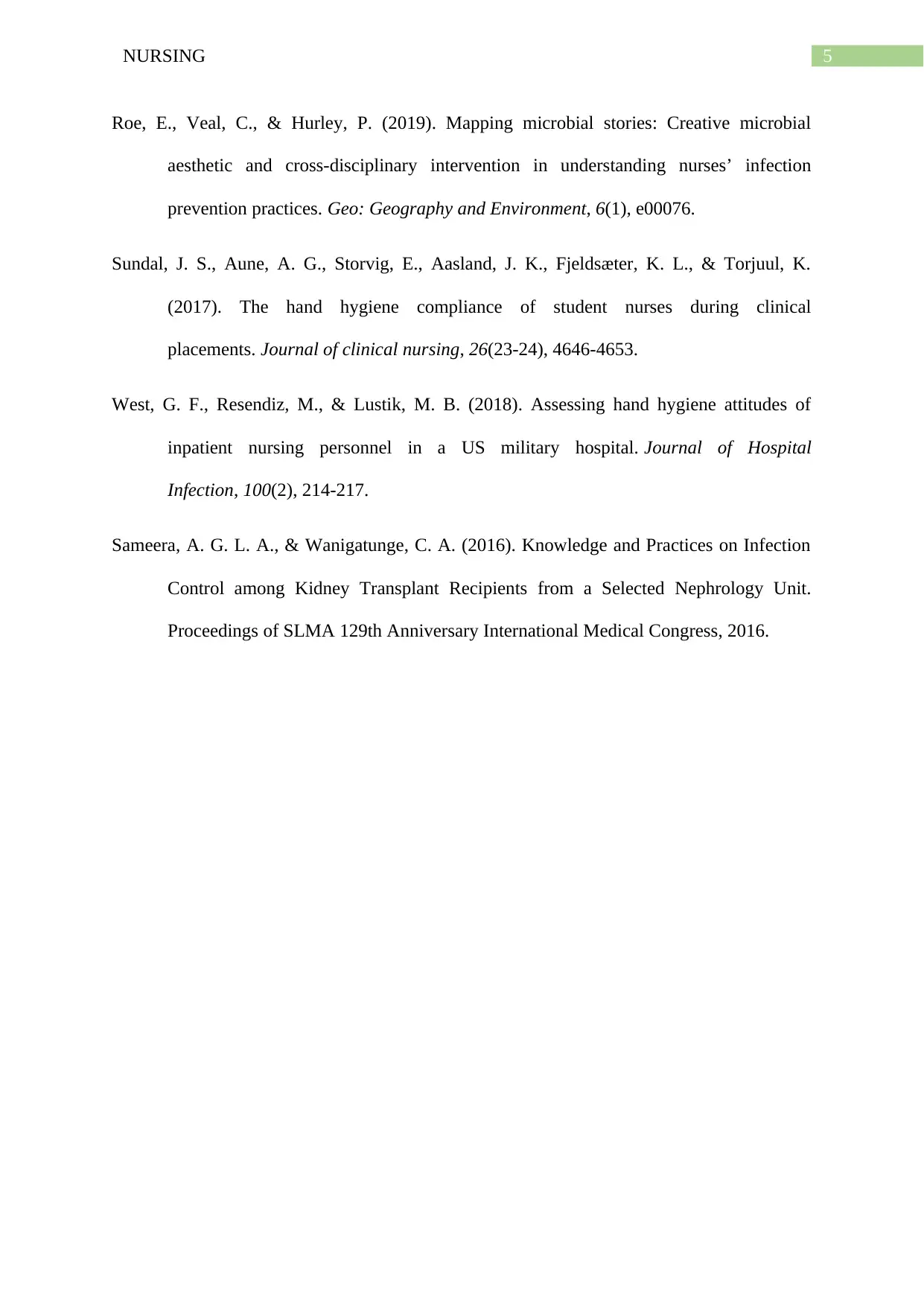
5NURSING
Roe, E., Veal, C., & Hurley, P. (2019). Mapping microbial stories: Creative microbial
aesthetic and cross‐disciplinary intervention in understanding nurses’ infection
prevention practices. Geo: Geography and Environment, 6(1), e00076.
Sundal, J. S., Aune, A. G., Storvig, E., Aasland, J. K., Fjeldsæter, K. L., & Torjuul, K.
(2017). The hand hygiene compliance of student nurses during clinical
placements. Journal of clinical nursing, 26(23-24), 4646-4653.
West, G. F., Resendiz, M., & Lustik, M. B. (2018). Assessing hand hygiene attitudes of
inpatient nursing personnel in a US military hospital. Journal of Hospital
Infection, 100(2), 214-217.
Sameera, A. G. L. A., & Wanigatunge, C. A. (2016). Knowledge and Practices on Infection
Control among Kidney Transplant Recipients from a Selected Nephrology Unit.
Proceedings of SLMA 129th Anniversary International Medical Congress, 2016.
Roe, E., Veal, C., & Hurley, P. (2019). Mapping microbial stories: Creative microbial
aesthetic and cross‐disciplinary intervention in understanding nurses’ infection
prevention practices. Geo: Geography and Environment, 6(1), e00076.
Sundal, J. S., Aune, A. G., Storvig, E., Aasland, J. K., Fjeldsæter, K. L., & Torjuul, K.
(2017). The hand hygiene compliance of student nurses during clinical
placements. Journal of clinical nursing, 26(23-24), 4646-4653.
West, G. F., Resendiz, M., & Lustik, M. B. (2018). Assessing hand hygiene attitudes of
inpatient nursing personnel in a US military hospital. Journal of Hospital
Infection, 100(2), 214-217.
Sameera, A. G. L. A., & Wanigatunge, C. A. (2016). Knowledge and Practices on Infection
Control among Kidney Transplant Recipients from a Selected Nephrology Unit.
Proceedings of SLMA 129th Anniversary International Medical Congress, 2016.
⊘ This is a preview!⊘
Do you want full access?
Subscribe today to unlock all pages.

Trusted by 1+ million students worldwide
1 out of 6
Related Documents
Your All-in-One AI-Powered Toolkit for Academic Success.
+13062052269
info@desklib.com
Available 24*7 on WhatsApp / Email
![[object Object]](/_next/static/media/star-bottom.7253800d.svg)
Unlock your academic potential
Copyright © 2020–2025 A2Z Services. All Rights Reserved. Developed and managed by ZUCOL.





